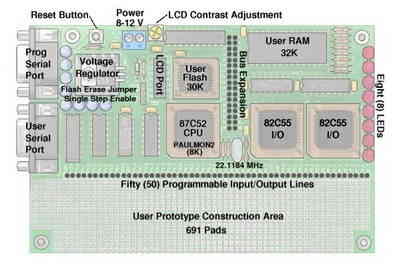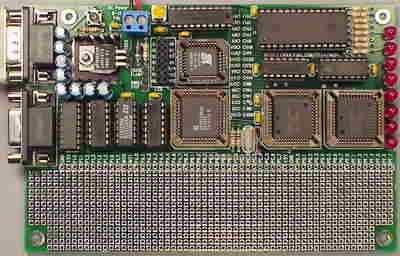
The 8051 development board provides an easy-to-use and low-cost way to develop your 8051 based microcontroller projects, without purchasing any other special equipment, such as IC programmers or emulators. All required software is available as a free download, including a C compiler

Features
Standard 87C52 CPU clocked at 22.1184 MHz
50 I/O lines!! All I/O lines are clearly labeled and available at the edge of the prototype construction area
32k SRAM, program variables and code (24k usable for code download)
30k Flash ROM, non-volatile program storage and data logging
High speed baud rates: 115200, 75600, 38400, etc. All standard baud rates are supported (except 300 baud)
Display port, works with standard character-based LCD A 16×2 display will be available from PJRC (see photo below)
Eight LEDs, controlled by 8 dedicated I/O lines (not shared with the 50 I/O lines)
Bus expansion with 4 chip select signals, for adding UARTs, A/D converters and other bus-based peripheral chips.
Unregulated, polarity-protected DC voltage input with 2 position terminal block.
PAULMON2 monitor for easy code development without additional equipment.
Requirements
DC Voltage, 8 to 15 volts (regulated), 50 mA or 300 mA with LCD.
PC Computer With Serial Port, Linux or Microsoft Windows 95-OSR2, 98, 98SE, NT4, 2000.
Assembler or Compiler, usually AS31 or SDCC
Terminal Emulation Program, eg Hyperterminal (windows), Minicom (linux)
Text Editor Program, eg Notepad, Vi, Emacs
Standard 9 pin serial cable (straight through, not null-modem!)
Source: pjrc.com/tech/8051/board4/index.html 8051 Sample Application and 8051 Development Board pcb code alternative link:
Şifre-Pass: 320volt.com
Published: 2008/08/28 Tags: development board projects
30W Class AB Mosfet Amplifier Circuit
A volume setting passive integrated possible by the high output level of modern sources, and a structure of the amplifier gain sufficient floors limited to essential guarantee the transparency of the system. Yield loudspeakers and damping for ‘pregnant will be the selection criteria.
A Release to push-pull “common drain”: his first schemes have 20dB of reaction against the level of DHT + noise is less than 0.05%, bandwidth than 200kHz. Le gain est de 29dB (x28). The gain is 29dB (x28). Very goods for pregnant crossover agreement and bass reflex. The damping more than 100 are pure generating tension.
Mosfet Amplifier Project